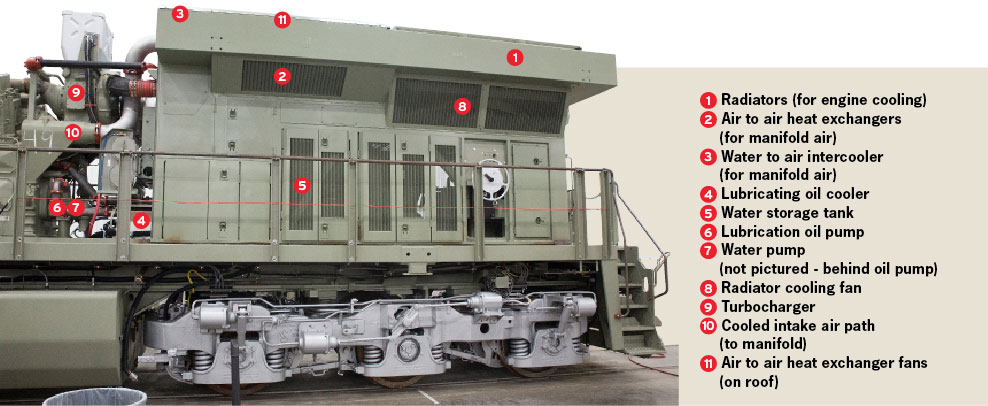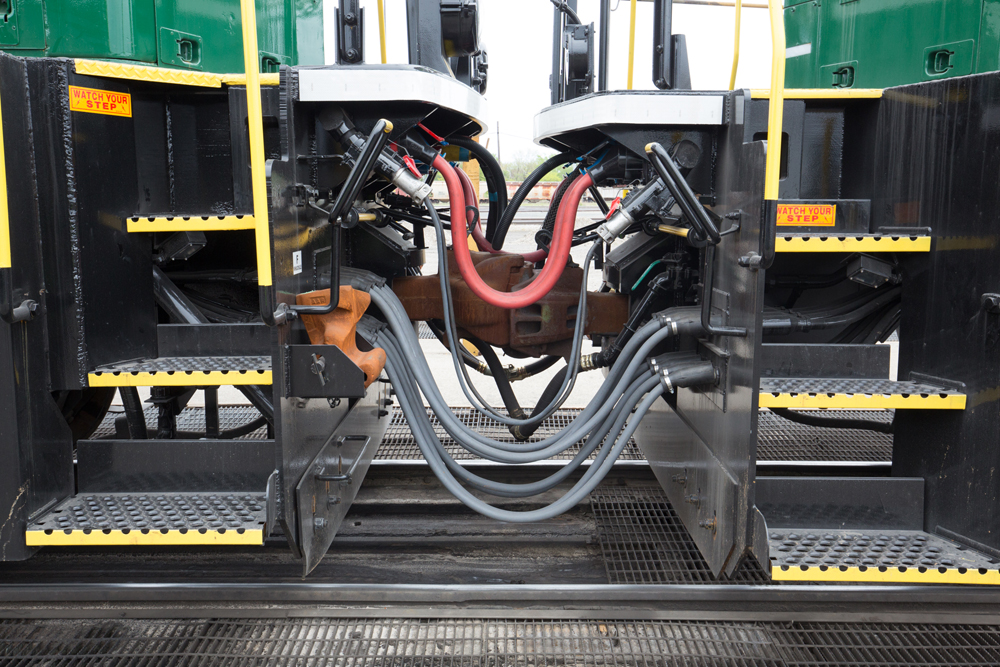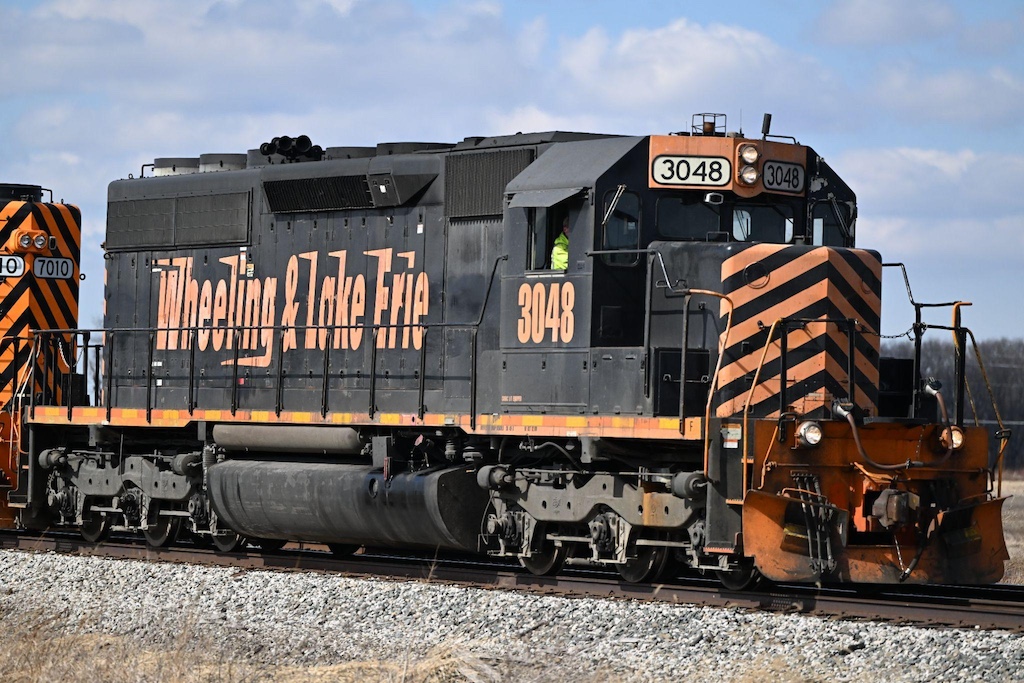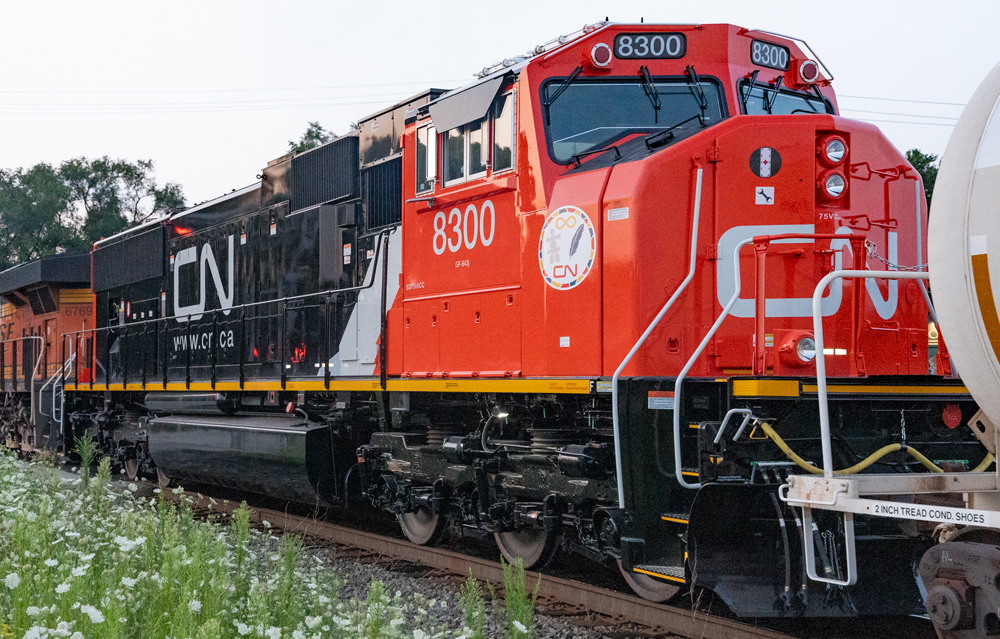Locomotive engine heat, left uncontrolled, can damage engine parts and shorten the life of the engine and its attached components. An effective radiator system keeps the engine and components at the optimum operating temperature, regardless of whether the locomotive is operating in mountains or flatlands or hot or cold. A locomotive radiator system primarily cools air, water, and oil. The air is used in the combustion process; the water for cooling the engine and turbo (if equipped); and oil for lubricating the engine components.
The radiator system is intended to keep the engine operating at nearly the same temperature, regardless of the ambient air outside the locomotive. This allows maximum horsepower to be available at all times and extends the life of the engine and its lubricants.
Electro-Motive Diesel and General Electric differ in radiator system design. EMD uses a “wet” radiator system in which fluid is cycled through the radiator system constantly while the engine is operating. GE on the other hand employs a “dry” system where fluids are routed through the radiator system only as conditions warrant. Each builder uses a system of valves to route fluids to banks of radiators to achieve the level of cooling needed at any given time. While both builders use fans on the main radiator banks to assist in cooling, EMD’s system also uses a shutter system to control the flow of air across the radiators.
Modern EMD and GE locomotives use a split cooling system with separate paths to reduce the coolant temperature to the levels required.
In split cooling on a GE locomotive, a majority of the fluid cooled in the radiator is sent back to the locomotive at one temperature while a portion of the coolant is routed through additional radiator banks called sub-coolers (or aftercoolers) for further temperature reductions. Once passed through these additional cooling banks, the fluid travels to various devices such as the air to water intercooler to assist in cooling the engine intake air. The combustion air is first drawn in and compressed in the turbocharger. Compression heats the air and must be cooled before being used for combustion. Cooler air is denser and is more oxygen-rich, making it a preferred manifold air temperature for increasing power, controlling emissions, and reducing fuel consumption. After passing though the intercooler, the intake air passes through a heat exchanger where additional cooling occurs if conditions warrant before going to the engine for combustion.
Another path from the sub-coolers is to the oil cooler, prior to the coolant returning it to the engine. Lubricating oil absorbs heat while inside the engine and needs to be cooled before returning. Subjecting lubricating oil to high heat shortens the life of the oil and would force more frequent oil changes to maintain the engine in good working order. Higher temperatures lower the viscosity (thickness) of oil, which increases the wear of internal components.
EMD utilizes a slightly different layout, with two separate loops from the engine, one for the radiator and oil cooler and another for the aftercooler. Various connections between the two loops allow the onboard computer to utilize excess cooling capacity in the aftercooler loop if needed.
The vast majority of locomotives on the road today utilize simple tap water for coolant in their radiator systems. Water is much more efficient at transferring heat than a mix of water and antifreeze that’s typically found in your car’s radiator system. Benefits of using water allow the overall size of the radiator system to be smaller due to its higher efficiency, the lower cost of water compared to antifreeze/water mixture, and water’s ubiquity. Any garden or water hose that can reach a locomotive can add fluid to the radiator system in a pinch. There are also environmental concerns with using antifreeze since the water system needs to be drained occasionally for maintenance. To keep the radiator system in top shape, a corrosion inhibitor is added to the water. This additive protects the system from developing rust, corrosion, and scaling.
With Tier 4 emissions regulations in effect as of Jan. 1, 2015, the radiator systems for both builders will change again. Further cooling will be necessary to achieve the new environmental standards. Trains will cover those changes after more Tier 4 locomotives are on the road.















Is there any need for water valves that have a freeze plug incorporated into the valve so that when it freezes the valve isn’t destroyed… the freeze tolerant ball valve has a freeze plug that works well in water systems exposed to freezing situations..
Do modern locomotives use plain water or a anti-freeze solution? I’ve heard just plain water. What type of valves are used in the water system? Is there any application for ball valves with freeze plugs?
This is an outstanding article. It is always interesting to learn more about the technical aspects to railroading. I hope you continue with other technical topics about the major (and minor) components of our modern locomotives. It makes train watching more fun when you understand all that is going in these massive wonders.
Loco's use water predominately because it has greater thermal conductivity than ethylene glycol. The water is treated with corrosion inhibitor consisting of nitrite/borate. In northern climates loco's will have a GURU valve which will automatically drain the cooling system water if the temperature approaches freezing. In order to avoid freezing and maintain engine block temperature the engines will be started and stopped periodically when not in use.
To answer John's question, a device called a "Hot Start" is installed on locomotives that see freezing temperatures. It is basically a 480 volt water heater and circulating pump that is turned on when the locomotive is shut down for any length of time. In very cold weather it is also common to let a unit idle between shifts or crew changes. In regards to Doug's comment,I have been welding for 28 years and find it hard to believe an engine manufacturer would make an engine that was not tested for water leaks.
Years ago I was talking to a worker in the engine terminal at Sparks, NV . The question came up about why they use water and not antifreeze. He though it had to do with the engine block because it is welded together and it is not cast. A car engine are usually cast and chance of a leak is small. A welded engine have cracks and water will leek through the cracks. Water and oil can be seperated if it was antifreeze it will dilute the oil and can't seperated. He said there is red light on the pole (he pointed) that when it goes "on" he has to go around and drain the water out of each of loco that are shut down. The temp is below freezing when the red light comes on( winter time) that probably why most engine a kept running in winter.
David Phelps-Thank you very much. I understand the EMD process, but on GE engines, without top mounted fans, how then does it exhaust the hot air to the atmosphere?
good article,but one ? we live by G E plant in Erie ,if they only use plain water what happens in winter below 32 ?
Very good article, very informative, was the SD-45 ahead of its time with its flared radiators?
Jesse – GE draws the air from the sides into the fans then blows it up through the radiators, while EMD sucks the air in from the sides and pulls it up through the radiators with top mounted fans that then exhaust the hot air to the atmosphere.
Same here, Lawrence, but I would have liked to see the radiator fans operations explained in more detail. Ex: Do both GE and EMD radiator fans draw air in from the sides, blow up thru the radiator and then out on top? Or do the fans draw air in from the top down thru the radiators exiting out of the side of engine grills?
Interesting that GE alone uses the same type cooling system as most class 3 and larger commercial trucks do. With that in mind a word of caution, if observing a CML truck and the engine is still hot DON"T put anything you can't afford to lose near the engine fan. It is controlled by a thermostat not by the ignition switch.
Answers many questions I've had over the years. Well-written and comprehensive.